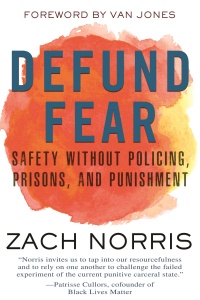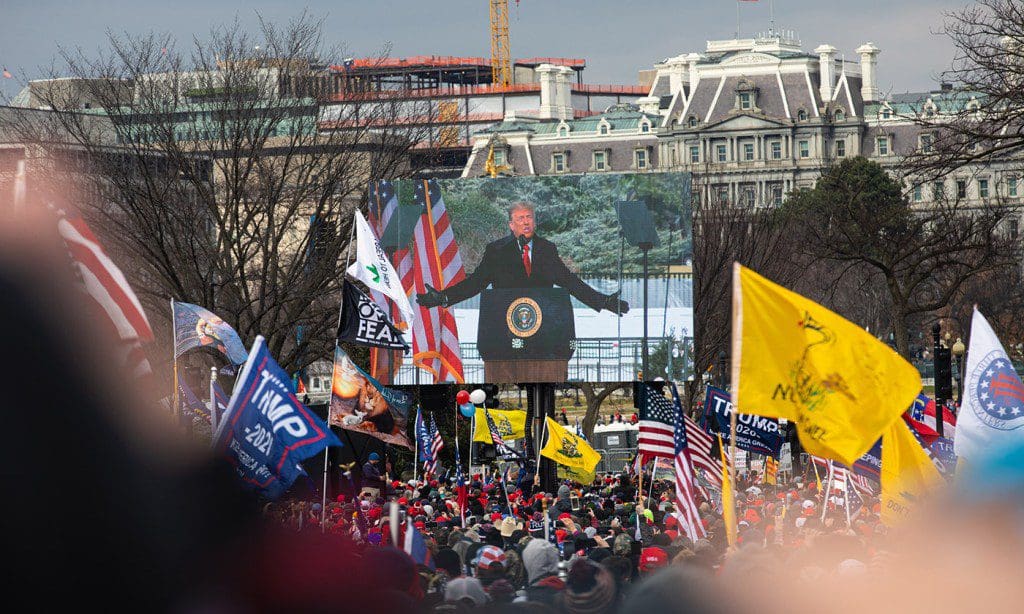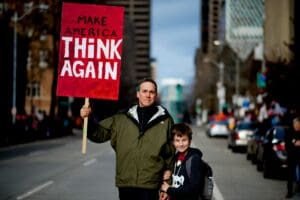The human “fight or flight” response gives demagogues like Trump a tool for political manipulation. But we could replace oppression with a system of care.
By Zach Norris
Threats both real and imagined can be used to manipulate us. It turns out that invoking safety—which inevitably means invoking threats to our safety—is an effective way to trigger automatic, irrational anxiety responses. The mere whiff of danger whips people up into a state of panic and sends us into an automatic “fight or flight” response, because our brains are finely tuned threat-detection devices. As humans evolved, those who recognized and avoided mortally dangerous things were the ones who survived to pass on their genes.
We are literally wired to pay attention to any hint of danger—and those threat detection-and-analysis processes in our brain happen mostly unconsciously and automatically, without the input of our rational brains. This makes us super susceptible to inflammatory rhetoric that magnifies uncertainties, risks, and threats.

“Politicians, journalists, advocacy groups, and marketers continue to blow dangers out of proportion for votes, ratings, donations, and profits,” writes Barry Glassner, the sociologist whose 1999 bestseller The Culture of Fear has been reprinted and updated for the Donald Trump era.
When people in power trigger anxieties and then promise a plan for safety, many are likely to embrace that plan. No matter the consequences.
Against the drumbeat of constant news coverage about active shooters, terrorist threats, and jobs taken by foreigners, the stage was set for an authoritarian strongman who promised to bring everything back under control. To protect our jobs, our wealth. To protect our way of life. To keep our homes and families safe. To make America great again. People were desperate for safety and security, and the strongman offered it at bargain prices.
The rise of fascism often occurs when great expectations have been smashed to bits. It thrives under conditions of economic inequality, where the gulf between haves and have-nots is deep and wide.
It was when the American Dream had shattered for so many that we were most susceptible to the rise of a strongman who promised to return us to bygone bucolic eras.
Connecting the dots between capitalism, inequality, and the politics of hatred, the economist Umair Haque writes: “What do people do as hardship begins to bite—especially those who expected comfortable, easy lives? They become reactionary, lashing out violently. They seek safety in the arms of demagogues. … It’s the once prosperous but now imploded middle which turns on the classes, ethnicities, groups, below it. The people who expected and felt entitled to lives of safety and security and stability—who anticipated being at the top of a tidy little hierarchy, the boss of this or that, the chieftain of that or this, but now find themselves adrift and unmoored in a collapsing society, powerless. … They turn to those who promise them just that superiority, by turning on those below them. … supremacy and dominion over the weak, the despised, and the impure.”
Our generalized anxiety and economic insecurity in the United States coincides with a demographic shift: the browning of America—a near future in which white folks will no longer be the majority. It has already impacted every city across the country and is now impacting small towns and rural areas as well.
For many who were previously the majority—white folks—this constitutes the ultimate threat, the dissolution of the long-standing social order, a kind of existential unraveling.
As john a. powell, legal scholar and author of Racing to Justice, notes: “When a person embraces the concept of supremacy, then equality is viewed as an attack. They believe this country belongs to whites. They believe that having people of color in positions of respect and power is un-American. There has been no greater example of a threat to their belief system than President Obama. It was not Obama’s policies they objected to, but his humanity.”
powell has written extensively about what he calls “othering”—systemic exclusion, and the rise of ethnic-nationalist and authoritarian politics.
Many of those who voted for Trump in 2016 did so because he conjured the image of a strongman who would protect them from threats, whether they were white voters fearing a loss of control over democracy in the wake of President Obama, or financially insecure voters feeling threatened by immigrants and globalization. Trump used people’s fears to fuel marginalization and dehumanization. He promised to lock up or lock out all those he claims have caused the downfall of the nation. Fascism makes Us vs. Them—the politics of hatred—into national policy.
Jason Stanley, professor of philosophy at Yale University and author of How Fascism Works, explains: “The story is typically that a once-great society has been destroyed … and you make the dominant group feel angry and resentful about the loss of their status and power. … The goal is to make them feel like victims, to make them feel like they’ve lost something and that the thing they’ve lost has been taken from them by a specific enemy, usually some minority out-group or some opposing nation.”
The Us vs. Them story goes this way: “they” threaten “our” way of life. “Our” successes are dependent on “their” losses in a zero-sum game. “They” cannot be trusted because “they” always lie. “They” are always to blame; “they” are dangerous and must be contained.
“They” are often described using language like primitives, savages, apes, vermin, infestations, and animals. And using the language of disease: contagions, germs, pollutants, infections.
Today one of the chief threats supposedly comes from Muslims, who are deemed threatening to the American way of life, and from our borders to the south: “They’re bringing drugs. They’re bringing crime. They’re rapists.” “We’re not going to have a country” if things don’t change, warns Donald Trump, ranting on about dangerous caravans of thousands of drug-dealing, murderous aliens closing in on our borders.
But the roots of Us vs. Them long pre-date the Trump administration, going way back to the beginning of our nation.
Native Americans were called savages and heathens who threatened Christian values. The Us vs. Them narrative facilitated the demonization of indigenous peoples and their removal from what would become the United States. Black people were not seen as people but as wild beasts to be tamed, as property. The Japanese Americans in 1942 were called the “yellow peril.”
The media of the time called them “sneaky,” “treacherous,” even “lecherous.” Political cartoons characterized the “Japs” as monkeys and as men who lusted after white women—stereotypes long applied to men of African descent as well. With language like “fatherless” and “wolf packs,” the social scientists who created the “superpredator” theory generated appeal for policies that targeted and dehumanized those youth, overwhelmingly boys of color. In the United States there has been a kind of musical chairs of oppression, where powerful white men set the tune and the last marginalized group standing is the first one scapegoated.
The rails upon which the train wreck of Trump’s administration is riding were laid by bipartisan predecessors going back decades. In the 1960s, as crime rates were on the rise, President Lyndon Johnson articulated one possible way to achieve public safety: to wage a war on poverty that focused on increasing investment in communities still ravaged by decades of disinvestment and Jim Crow segregation. But interest in that strategy was short-lived. Richard Nixon campaigned and won election with a focus on “law and order.” In so doing, he helped launch what would become the largest prison-building boom in human history.
Year after year, politicians of all stripes, especially at the state and local levels, fought to demonstrate who could come up with the toughest “tough-on-crime” attitudes, the longest sentences. Decades later, despite the failure of this approach, the law and order politics of Bill Clinton and the “superpredator” rants of Hillary Clinton kept hammering the same notes.
Elsewhere, other similarly situated Western democracies chose to make deep investments in social welfare. Today they have much lower crime rates and lesser levels of inequality. They invested in a social safety net, while we invested in a punishment dragnet. They invested in care, while we invested in fear.
If lawmakers in the US had taken the path of investment to address issues most salient in poor communities, rather than dehumanization, deprivation, and punishment, it would have benefited everyone. We might now be in an era of less harm and greater prosperity for all.
Instead, America invested in systemic dehumanization, a choice that had the backing of Democrats and Republicans alike. Of all the bipartisan strategies of the past 50 years, this may be most responsible for the rise of fascism in the United States today.
From Fear to Care
There are two ways to think about safety. There is a fear-based way and a care-based way. For the fear-based model, architects of anxiety cultivate and stoke the Us vs. Them mindset, based on a zero-sum mentality around the idea of scarcity: that there is not enough of the good stuff for everyone. This fundamental divisive and adversarial mindset extends beyond politics (Democrats vs. Republicans), race (white vs. people of color), and class (rich vs. poor) into most institutions. In housing we have landlords vs. tenants; in the law we have plaintiffs vs. defendants; in health care we have insurance companies vs. patients.
When we set two sides against each other, rather than acknowledging they are components of one whole, the result is always less safety for both sides. Two-sided is always lopsided.
The fear-based model defines safety only in terms of being free from crime and criminals, which is limited, and limiting. This has resulted in a criminal legal system that holds close to seven million adult Americans in jail, in prison, on parole, or on probation. With or without literal incarceration, millions of people are cast as “others” and “bad guys,” including many children who have a hard time focusing in school, many people whose anxiety and depression pushes them to consider suicide, and many people who miss a paycheck, get evicted, and have to sleep in their car.
Over the past nearly 250 years, the architects of anxiety have leveraged the Us vs. Them mentality and the zero-sum mindset to select groups of people to scapegoat, based on their race and ethnic backgrounds, their belief systems, their abilities, or sexual and gender identities.
These architects then created and steadily expanded what I call the “framework of fear,” which employs four key elements: systematic deprivation, extensive and expensive systematic suspicion, cruel punishment, and often-permanent isolation from the rest of society.
According to the architects of anxiety, this framework should keep us safe. In fact, it has done just the opposite.
The framework of fear has led to the traumatization of not just the individuals who have been targeted, dehumanized, and criminalized, but the traumatization of entire communities, unfathomable devastation that will be decades in the reckoning. Because trauma is as much a chief cause of violence, as the result of violence, our current fear-based system paradoxically generates more harm than it prevents, in never-ending cycles of trauma.
Perhaps most importantly, our democracy itself has been compromised by the climate of scarcity, suspicion, and dehumanization that the fear-based model of safety has propagated. In the last forty years, Americans’ participation in associations and civic organizations has declined, while trust in government and satisfaction with democracy have plummeted. That coincides with our economic inequality growing by leaps and bounds as well as the explosion of our prison population. Those things can’t be disconnected. The fear-based framework threatens not just our agency as individuals but also our democracy as a collective.
This moment presents the opportunity to take action toward a culture of caring and policies of caring. We need to shift our focus from individual criminals and what qualifies as crimes, to what actually causes most suffering and damage.
The real threats to our safety are not coming from a few bad apples; they simultaneously come from powerful massive institutions and “-isms” (racism, capitalism) that we all have a hand in upholding and from within our own families and communities.
The care-based approach asks how do we care for ourselves and each other so that we all can be safe. A new care-based model of safety can replace deprivation, suspicion, punishment, and isolation with resources, relationships, accountability, and participation, what taken together I call a “culture of care.”
A culture of care prevents many harms from happening in the first place, by investing in a social safety net (resources), by building our capacity to relate to one another across difference (relationships), and by increasing our sense of “skin in the game” with more vibrant engagement on every level, within neighborhoods, and within our democracy and society (participation).
Care-based safety also means we address harms in ways that hold people accountable and bring about healing (accountability). It means we tackle all the harms going unaddressed by the current system: on the one end of the spectrum, the really huge harms perpetrated by huge institutions, over history, and on the other end of the spectrum, the interpersonal harms like domestic violence and sexual abuse.
In terms of paying for the shift from fear to care, where there’s a will, there’s a way.
Much of the billions that we currently spend each year on the framework of fear, incarceration in particular, can be reallocated and used as investments in programs and services that keep us healthy and safe. A tax on the rich that merely matches the rate that was in place from 1913 until 1982 (70 percent for the highest tax bracket) also can be partially allocated to a social safety net that benefits everyone.
Despite all the talk about “public safety,” there is very little public in our safety system. We need holistic solutions to ensure our communities have the safety and security necessary to thrive. A care-based model of safety includes all the things that create and maintain stability and well-being on the level of the individual, the family, the community. The care-based approach gives all young people the opportunity to become responsible, engaged, and empathetic participants in their communities.
Safety is not tied to our capacity to watch our neighbors, but rather based on our capacity to truly look out for one another. There is no doubt in my mind that we are safer when we act together than when we let ourselves be divided.
_____
Excerpted from Defund Fear: Safety Without Policing, Prisons, and Punishment by Zach Norris (Beacon Press, 2021). Reprinted with permission from Beacon Press.
ZACH NORRIS is the executive director of the Ella Baker Center for Human Rights, which creates campaigns related to civic engagement, violence prevention, juvenile justice, and police brutality, with a goal of shifting economic resources away from prisons and punishment and towards economic opportunity. He is also the cofounder of Restore Oakland and Justice for Families, both of which focus on the power of community action. He graduated from Harvard and took his law degree from New York University.
Connect with him at zachnorris.com or on Twitter.
To see original article please visit: https://www.yesmagazine.org/democracy/2021/01/11/anxiety-authoritarianism-culture-of-care/






















